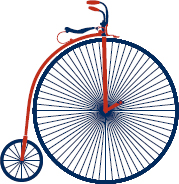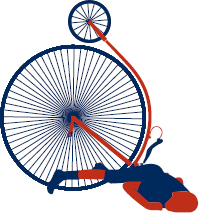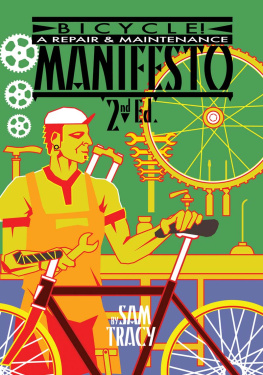Eben Weiss - The Ultimate Bicycle Owners Manual
Here you can read online Eben Weiss - The Ultimate Bicycle Owners Manual full text of the book (entire story) in english for free. Download pdf and epub, get meaning, cover and reviews about this ebook. year: 2016, publisher: Running Press, genre: Romance novel. Description of the work, (preface) as well as reviews are available. Best literature library LitArk.com created for fans of good reading and offers a wide selection of genres:
Romance novel
Science fiction
Adventure
Detective
Science
History
Home and family
Prose
Art
Politics
Computer
Non-fiction
Religion
Business
Children
Humor
Choose a favorite category and find really read worthwhile books. Enjoy immersion in the world of imagination, feel the emotions of the characters or learn something new for yourself, make an fascinating discovery.

- Book:The Ultimate Bicycle Owners Manual
- Author:
- Publisher:Running Press
- Genre:
- Year:2016
- Rating:5 / 5
- Favourites:Add to favourites
- Your mark:
- 100
- 1
- 2
- 3
- 4
- 5
The Ultimate Bicycle Owners Manual: summary, description and annotation
We offer to read an annotation, description, summary or preface (depends on what the author of the book "The Ultimate Bicycle Owners Manual" wrote himself). If you haven't found the necessary information about the book — write in the comments, we will try to find it.
The Ultimate Bicycle Owners Manual — read online for free the complete book (whole text) full work
Below is the text of the book, divided by pages. System saving the place of the last page read, allows you to conveniently read the book "The Ultimate Bicycle Owners Manual" online for free, without having to search again every time where you left off. Put a bookmark, and you can go to the page where you finished reading at any time.
Font size:
Interval:
Bookmark:

In accordance with the U.S. Copyright Act of 1976, the scanning, uploading, and electronic sharing of any part of this book without the permission of the publisher constitute unlawful piracy and theft of the authors intellectual property. If you would like to use material from the book (other than for review purposes), prior written permission must be obtained by contacting the publisher at permissions@hbgusa.com. Thank you for your support of the authors rights.
To receive special offers, bonus content, and news about ourlatest ebooks and apps, sign up for our newsletters.
Sign Up
Or visit us at hachettebookgroup.com/newsletters
Copyright 2016 by Eben Weiss
Illustrations by Alex Merto and Eric Ku
Cover design by Alex Merto
Interior design by Elizabeth Van Itallie
All rights reserved. In accordance with the U.S. Copyright Act of 1976, the scanning, uploading, and electronic sharing of any part of this book without the permission of the publisher constitute unlawful piracy and theft of the authors intellectual property. If you would like to use material from the book (other than for review purposes), prior written permission must be obtained by contacting the publisher at permissions@hbgusa.com. Thank you for your support of the authors rights.
Black Dog & Leventhal Publishers
Hachette Book Group
1290 Avenue of the Americas, New York, NY 10104
blackdogandleventhal.com
hachettebooks.com
First ebook edition: May 2016
Black Dog & Leventhal Publishers is an imprint of Hachette Books, a division of Hachette Book Group.
The Black Dog & Leventhal Publishers name and logo are trademarks of Hachette Book Group, Inc.
The publisher is not responsible for websites (or their content) that are not owned by the publisher.
ISBN 978-0-316-35267-3
E3
To everyone who is about to discover the joy, beauty, and practicality of cycling.
S o youve decided to get a bicycle.
Congratulations!
If you feel confused and overwhelmed by the vast and bewildering bicycle marketplace, dont worry, because admitting you need help is the first step toward becoming a cyclist. Before we go any further, it will help if you have a basic understanding of the history of the bicycle.
In the 1870s, buying a bicycle was easy: You went to Ye Olde Velocipede Shoppe, picked out a nice high-wheelerknown as the penny farthingand maybe took a header into a pile of horse manure on the way home. Done. Shopping was easy. The hardest part was riding the thing. First, in order to get started, you had to give the bike a push from behind. Then you had to scramble on top of it while it was rolling, which would have been like climbing onto the roof of a Volkswagen Beetle. Once you were up there, you had to stay up there, which was not easy, thanks to the fact that you were essentially sitting on top of a giant wheel. Its hard to stay upright on a bicycle when your center of gravity is way up on the third floor. If you were able to mount and ride the bike successfully, you still had to climb back down when the ride was over.
Seems like a lot of work, right? Why was that front wheel so gigantic anyway?
Because the penny farthing was propelled by means of a direct drive, which means the pedals and cranks were attached directly to the front wheel. So, the diameter of the wheel is what determined how fast and far the bicycle would go when your legs turned the pedals. If the wheel was small, youd have to pedal frantically in order to get anywhere. (Think about how long it would take you to travel a mile on a childs tricycle and youve got the idea.) Therefore, the front wheel was laughably huge.
Even so, people went crazy for the penny farthing, and the world experienced the very first bike boom.
Then, two big things happened.
1. In 1885, John Kemp Starley began manufacturing a rear-wheel, chain-drive bicycle with more or less symmetrical wheels.
2. John Boyd Dunlop founded the Dunlop Pneumatic Tire Co. in 1889.
Equal-size wheels? Air-filled tires? This was cyclings chocolate-in-the-peanut-butter moment. Fitting a bicycle with a chain drive meant that you no longer had to change the wheels diameter in order to optimize the systems mechanical advantage. Instead, the gear ratio was determined by the size of the chainring and cogs, which were mounted on the hub of the rear wheel. And presto, a rear-wheel-driven bicycle that could be designed for comfort. Starleys bike, with its diamond frame and two symmetrical wheels, was vastly more stable than a penny farthing, and it was far easier to straddle and ride. As you can imagine, riding a bicycle with symmetrical wheels wrapped in cushions of air was a much more attractive proposition than bouncing around high above the manure-strewn streets on solid tires. It was also a lot safer, for the simple reason that you were much less likely to fall off your bike. In fact, this new design was marketed as the safety bicycle. By the end of the nineteenth century, pretty much all bicycles were rear-wheel-driven safety bicycles rolling on pneumatic tires. The machine became so popular that cities and municipalities began paving the roads with macadam in order to accommodate the growing legions of cyclists.
So you can thank bicycles for paved roads, and you can also feel free to tell any impatient driver who says roads are for cars that they should be thanking you for the pavement theyre driving on.

Penny farthing.

Penny farthing fail.
Now were well into the twenty-first century, and here you are looking for a bike. The good news is that fundamentally not much has changed about the bicycle since the turn of the last century: Were still (mostly) riding diamond-framed safety bicycles with pneumatic tires. (Yes, there are recumbents and other rethinkings of the upright bicycle, but well address those later.) Sure, bikes have gotten a lot lighter, and yes they have much more sophisticated gear changing and braking systems, but if a late nineteenth-century cyclist were to ride through a time wormhole into today, he or she would have no difficulty riding any of my bikes. (Apart from dodging all the cars of course, but well address that later as well.)
The bad news is that a century of constant refinement, endless marketing, and incessant hyperspecialization means that shopping for a bicycle can be as vexing as trying to see the UFO in one of those Magic Eye paintings. In fact, you may be so frustrated youre ready to say, Screw it, Im leasing a Hyundai. Dont give up. The problem is more with the twenty-first century than it is with cycling. Bikes are simple machines, and unfortunately the simpler something is, the easier it is to ascribe all sorts of mystical attributes to it. Thats why people take classes in order to learn how to drink wine, but when they go to lease a Hyundai theyll make their decision based on the location of the cup holder.
Ultimately, the secret to choosing a bicycle is avoiding confusion, so here are some basic dos and donts to keep you on track, starting with the donts.
Font size:
Interval:
Bookmark:
Similar books «The Ultimate Bicycle Owners Manual»
Look at similar books to The Ultimate Bicycle Owners Manual. We have selected literature similar in name and meaning in the hope of providing readers with more options to find new, interesting, not yet read works.
Discussion, reviews of the book The Ultimate Bicycle Owners Manual and just readers' own opinions. Leave your comments, write what you think about the work, its meaning or the main characters. Specify what exactly you liked and what you didn't like, and why you think so.




![Trade Trade - Porsche 356 owners workshop manual: [1957-1965]](/uploads/posts/book/237774/thumbs/trade-trade-porsche-356-owners-workshop-manual.jpg)


